
The violoncello ( VY-ə-lən-CHEL-oh, Italian pronunciation:[vjolonˈtʃɛllo]), often simply abbreviated as cello ( CHEL-oh), is a bowed (sometimes plucked and occasionally hit) string instrument of the violin family. Its four strings are usually tuned in perfect fifths: from low to high, C2, G2, D3 and A3. The viola's four strings are each an octave higher. Music for the cello is generally written in the bass clef, with tenor clef, and treble clef used for higher-range passages.

The double bass, also known as the upright bass, the acoustic bass, or simply the bass, is the largest and lowest-pitched chordophone in the modern symphony orchestra. Similar in structure to the cello, it has four or five strings.
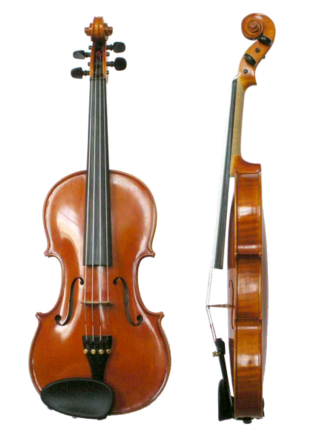
The violin, colloquially known as a fiddle, is a wooden chordophone, and is the smallest, and thus highest-pitched instrument (soprano) in regular use in the violin family. Smaller violin-type instruments exist, including the violino piccolo and the pochette, but these are virtually unused. Most violins have a hollow wooden body, and commonly have four strings, usually tuned in perfect fifths with notes G3, D4, A4, E5, and are most commonly played by drawing a bow across the strings. The violin can also be played by plucking the strings with the fingers (pizzicato) and, in specialized cases, by striking the strings with the wooden side of the bow.

The viola ( vee-OH-lə, Italian:[ˈvjɔːla,viˈɔːla]) is a string instrument of the violin family, and is usually bowed when played. Violas are slightly larger than a violin, it has a lower and deeper sound. Since the 18th century, it has been the middle or alto voice of the violin family, between the violin (which is tuned a perfect fifth higher) and the cello (which is tuned an octave lower). The strings from low to high are typically tuned to C3, G3, D4, and A4.

The vielle is a European bowed stringed instrument used in the medieval period, similar to a modern violin but with a somewhat longer and deeper body, three to five gut strings, and a leaf-shaped pegbox with frontal tuning pegs, sometimes with a figure-8 shaped body. Whatever external form they had, the box-soundchest consisted of back and belly joined by ribs, which experience has shown to be the construction for bowed instruments. The most common shape given to the earliest vielles in France was an oval, which with its modifications remained in favour until the Italian lira da braccio asserted itself as the better type, leading to the violin.

The cittern or cithren is a stringed instrument dating from the Renaissance. Modern scholars debate its exact history, but it is generally accepted that it is descended from the Medieval citole. Its flat-back design was simpler and cheaper to construct than the lute. It was also easier to play, smaller, less delicate and more portable. Played by people of all social classes, the cittern was a popular instrument of casual music-making much like the guitar is today.
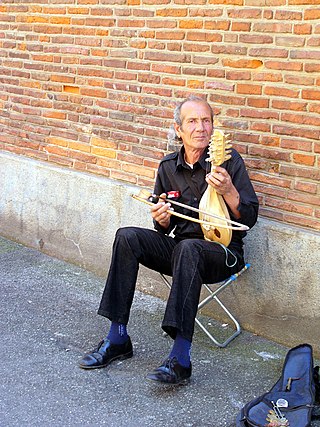
The gadulka is a traditional Bulgarian bowed string instrument. Alternate spellings are "gǎdulka", "gudulka" and "g'dulka". Its name comes from a root meaning "to make noise, hum or buzz". The gadulka is an integral part of Bulgarian traditional instrumental ensembles, commonly played in the context of dance music.
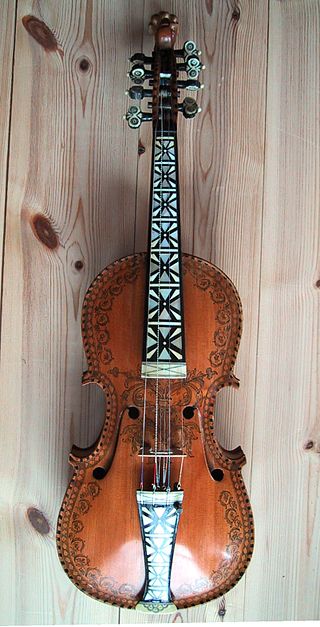
A Hardanger fiddle is a traditional stringed instrument considered to be the national instrument of Norway. In modern designs, this type of fiddle is very similar to the violin, though with eight or nine strings and thinner wood. The earliest known example of the hardingfele is from 1651, made by Ole Jonsen Jaastad in Hardanger, Norway. Originally, the instrument had a rounder, narrower body. Around the year 1850, the modern layout with a body much like the violin became the norm.

The kamancheh is an Iranian bowed string instrument used in Persian, Azerbaijani, Armenian, Kurdish, Georgian, Turkmen, and Uzbek music with slight variations in the structure of the instrument. The kamancheh is related to the rebab which is the historical ancestor of the kamancheh and the bowed Byzantine lyra. The strings are played with a variable-tension bow.

A tailpiece is a component on many stringed musical instruments that anchors one end of the strings, usually opposite the end with the tuning mechanism.

The ektara is a one-stringed musical instrument used in the traditional music of the Indian subcontinent, and used in modern-day music of Bangladesh, India, and Pakistan.
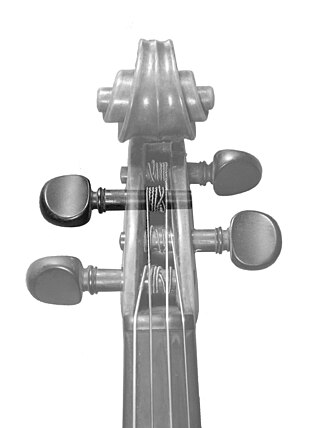
A variety of methods are used to tune different stringed instruments. Most change the pitch produced when the string is played by adjusting the tension of the strings.
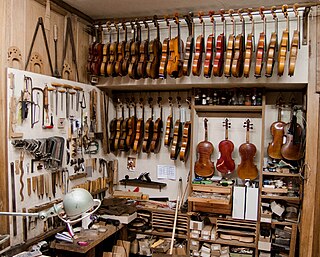
Making an instrument of the violin family, also called lutherie, may be done in different ways, many of which have changed very little in nearly 500 years since the first violins were made. Some violins, called "bench-made" instruments, are made by a single individual, either a master maker or an advanced amateur, working alone. Several people may participate in the making of a "shop-made" instrument, working under the supervision of a master. This was the preferred method of old violin makers who always put their names on violins crafted by their apprentices. Various levels of "trade violin" exist, often mass-produced by workers who each focus on a small part of the overall job, with or without the aid of machinery.

A violin consists of a body or corpus, a neck, a finger board, a bridge, a soundpost, four strings, and various fittings. The fittings are the tuning pegs, tailpiece and tailgut, endpin, possibly one or more fine tuners on the tailpiece, and in the modern style of playing, usually a chinrest, either attached with the cup directly over the tailpiece or to the left of it. There are many variations of chinrests: center-mount types such as Flesch or Guarneri, clamped to the body on both sides of the tailpiece, and side-mount types clamped to the lower bout to the left of the tailpiece.

Playing the violin entails holding the instrument between the jaw and the collar bone. The strings are sounded either by drawing the bow across them (arco), or by plucking them (pizzicato). The left hand regulates the sounding length of the strings by stopping them against the fingerboard with the fingers, producing different pitches.

The dramyin or dranyen is a traditional Himalayan folk music lute with six strings, used primarily as an accompaniment to singing in the Drukpa Buddhist culture and society in Bhutan, as well as in Tibet, Ladakh, Sikkim and Himalayan West Bengal. It is often used in religious festivals of Tibetan Buddhism. The instrument is played by strumming, fingerpicking or plucking. The dramyen, chiwang (fiddle), and lingm (flute) comprise the basic instrumental inventory for traditional Bhutanese folk music.

The lavta is a plucked string music instrument from Istanbul.

The choghur is a plucked string musical instrument common in Azerbaijan and Georgia. It has 4 nylon strings.

The classicalkemenche, Armudî kemençe or Politiki lyra is a pear-shaped bowed instrument that derived from the medieval Greek Byzantine lyre.

The quinton is a bowed musical instrument, in use mostly in France in the 18th century. It takes its name from the fact that, in ensembles, it played the quinta vox or quintus. Another derivation of the name may be from the number of strings and for consonance with violon. By the same name it is sometimes denoted the pardessus de viole, an originally six-stringed instrument of the family of the viols, since the pardessus lost one string and adopted the same tuning of the quinton. However, while the pardessus is viol-shaped, the quinton is violin-shaped.




















